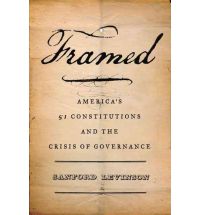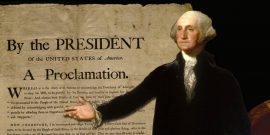If we would become a happier nation by being a more grateful nation, we need changes in public life that would call forth more gratitude.
Sanford Levinson's New Constitutional Settlement
Sanford Levinson here sets himself the task of examining not what he calls the “Constitution of Conversation,” but what he terms the “Constitution of Settlement.” He notes that many people devote barrels of ink to proposing meanings that they hope to see imputed to a few clauses of the Constitution: the Commerce Clause, the Necessary and Proper Clause, the General Welfare Clause, the Equal Protection Clause, and the Due Process Clauses. These clauses and a few others make up Levinson’s “Constitution of Conversation.”
On the other hand, virtually no attention is paid to clauses such as the Inauguration Clause or the requirement that senators be at least thirty years old. Yet, Levinson says, the portions of the Constitution that are rarely discussed deserve serious attention. While the Constitution of Conversation may fascinate, many of the Constitution of Settlement’s provisions have effects at once notable and unnoticed. If he had his way, many of them would be either reframed or scrapped. “It is the very point of” these sections, he says, “to foreclose conversations about meaning,” and they have succeeded to a large extent in doing so. He will remedy the problem. (p. 19)
Take, for example, the Twentieth Amendment’s establishment of January 20 as the end date of presidential and vice presidential terms. Levinson complains that this date leaves too long a period between the election and the inauguration. That period can be a very awkward one, he laments, when the outgoing president has been repudiated in the recent election. Far from meekly accepting that “that’s just the way it is,” Levinson insists we ought to contemplate eliminating the interregnum. Yet, the Constitution does not require that presidential elections be held in November; a nineteenth-century statute set the date. In addition, as has appeared repeatedly in American history—most recently in 2000—election disputes can take several weeks to resolve.
Many of Levinson’s specific objections are susceptible of this kind of answer. His general point is not. Quite a lot about the U.S. Constitution needs to be altered, and a strong element of America’s civil religion counsels us against even considering the possibility. He and your reviewer agree about that, even as we disagree about which portions of the Constitution ought to be corrected.
Much of Levinson’s argument, here as in his previous book Our Undemocratic Constitution: Where the Constitution Goes Wrong (and How We the People Can Correct It), rests on an undeveloped assertion. Levinson says that the Preamble to the Constitution lays out “aspirations” for the federal political order. Levinson concedes that the Preamble has never been taken by federal courts to grant any substantive power to the Federal Government (p. 59). He even shows Edmund Randolph, whom he identifies as “the nation’s first attorney general” (Ibid.), saying to President George Washington in 1791 that to read the Preamble as granting power would be to undo the careful delegation of powers found in the rest of the Constitution. Levinson does this, however, only to take issue with Randolph: if it be true that the aims mentioned in the Preamble were to be met only by granting the powers enumerated in the rest of the Constitution, Levinson asks, might it not be found that those grants were inadequate to the purpose? Might not one in time decide that “the power delineated” had proven inadequate?
Levinson’s description of Randolph is a bit too cute: far more significantly than serving as George Washington’s first attorney general (at the time a relatively minor role), Randolph took a leading role in drafting and ratifying the Constitution. In the Philadelphia Convention, he both sponsored the Virginia Plan (known at the time as “Randolph’s Resolutions”) and played one of the half-dozen most prominent roles in the Convention’s debates. As governor of Virginia, Randolph then returned to the Old Dominion and laid out what proved a key argument in favor of amending the Constitution—thus helping to pave the way for the Bill of Rights. Finally, he proceeded to the Richmond Ratification Convention, where his repeated insistence that the Federal Government would have only the powers “expressly” delegated proved pivotal to the most important state’s narrow ratification of the Constitution.
Randolph knew that the argument he was presenting to George Washington in 1791 was precisely the argument that had won the day in Richmond in the summer of 1788. He also knew that although the Richmond Convention considered each line of the Constitution in succession, it started with Article I, Section 1, Clause 1. The Preamble did not even merit discussion. Why? It was a mere statement of purpose, as all preambles were.
Is Levinson aware of this history? If so, he demonstrates his skill as an advocate by omitting it all.
Levinson devotes extensive attention to the extra-legal process through which the Constitution came into being in the first place. The Confederation Congress followed the Annapolis Convention (1786) in its suggestion in calling a second convention to meet in Philadelphia in summer 1787 for the purpose of proposing amendments to the Articles of Confederation. States other than Rhode Island deputed delegates to pursue that aim. Yet, nationalists led by James Madison quickly moved at the Philadelphia Convention’s start to propose an entirely new constitution. The rest is history. (Kevin R. C. Gutzman, James Madison and the Making of America)
With the events of 1786-87 as prelude, Levinson proposes that similar steps be taken now. Leaving aside the requirements of Article V of the Constitution, Levinson would have a randomly selected assemblage of American citizens concoct amendments to the Constitution, and a national referendum ratify the new substitute. Article V leaves it in the small states’ power to thwart any attempt to strip them of their equality in the Senate, he notes, and the example of 1787.
The changes he envisions would instantiate today’s leading liberal nostrums more firmly in the country’s fundamental law. Most of those principles come not from legitimately adopted amendments, or even statutes, but from other sources. Opinions of the Warren Court, for example. The arguments he makes for considering these principles to have widespread support are varied.
For example, he mentions a couple of times that the U.S. Supreme Court has invoked the Preamble. Those do not help his case. In the first instance, that of Chisholm v. Georgia (1793), the line of reasoning that rested on the Preamble led the Court to claim jurisdiction over a class of cases to which Article III’s enumeration does not extend. Within months of Chisholm’s decision, Congress sent the states what became the 11th Amendment, which expressly denies federal courts jurisdiction over such cases. One can read the 11th Amendment as the people’s insistence that Randolph’s reading of the Constitution applies to Article III—and that he was right about the Preamble.
The other instance of Supreme Court discussion of the Preamble to which Levinson refers comes in John Marshall’s opinion for the Court in McCulloch v. Maryland (1819). Levinson rightly calls that decision “canonical.” What he omits, however, is that when James Madison read Marshall’s opinion, he said that if the people had known the Constitution would be read that way, they would never have ratified it. Another way of putting Madison’s point is that if the people had known the Supreme Court would not apply the Constitution as Randolph explained it to Washington in 1791—as Randolph had explained it to the Virginia Ratification Convention, they would never have ratified it. Madison, like Randolph, was right.
Thus far, Levinson’s book is marred by a characteristic feature of law professors’ scholarship: reliance partly on judicial opinions, in lieu of ratification debates, to establish original understanding. Unfortunately, Levinson also falls into the other trap that most commonly ensnares legal academics seeking to elucidate constitutional meaning: over-reliance on The Federalist. While that series of essays had far less influence on the ratification contest than is commonly supposed (Ibid., ch. 4; and Albert Furtwangler, The Authority of Publius), Levinson is not alone among law professors in calling the arguments of Hamilton, Madison, and Jay “the ‘official’ defense” of the Constitution. (p. 179)
There are obvious potential explanations for legal academics’ tendency to rely on Publius so strongly. One is that legal training in this area does not extend beyond judicial opinions and a few snatches of The Federalist. Thus armed, and branded “doctors of law,” lawyers are invincible to the actual history of the ratification process—in which the Federalists’ chief aim was to sell the people on the idea that the Constitution would create a carefully limited government. The other is that the history of the debates in the several states, full as it is of promises by leading Federalists in South Carolina, North Carolina, Virginia, Maryland, Pennsylvania, New York, and Massachusetts (at least) that Congress would have only a few legislative powers, does not conduce to the outcomes they favor.
Levinson makes clear in this book, as in his last, that he strongly disapproves the remaining federal (as opposed to national) features of the American political system. Among these are the existence and structure of the Senate, the existence and structure of the Electoral College, and the amendment process. Thus, this book dwells at length on the Progressives’ state-level legacy of direct democracy, whether through initiative, through referendum, or through ease of constitutional revision. Since “we” approve of such mechanisms at the state level, and since many other countries have far more democratic systems of national (rarely federal) government than the USA, oughtn’t the American people go in for change along those lines in their federal system?
The extra-constitutional mechanisms that Levinson might endorse include dictatorship. After rehearsing the opinions, explicit and implicit, of unlimited-government advocates Machiavelli, Hamilton, Lincoln, and Ben Bernanke on executive power, Levinson deduces that dictatorship is sometimes necessary. He then devotes a section to the question how a constitutional dictatorship might be structured. (pp. 375-81)
Suppose one believed that untrammeled power was a negative, that Hayek deserved the Nobel Prize he won for demonstrating that such as Bernanke have caused the boom-and-bust economic cycle through which we presently suffer, that presidents who suspend the writ of habeas corpus or launch undeclared wars deserve impeachment rather than glorification, and that Alexander Hamilton and other monarchists ought to have been drummed out of the Philadelphia Convention? Not a word of that here.
Again, Levinson and I agree on the need for constitutional revision, though chiefly for different reasons. He and I share the belief that America is in a “crisis of governance,” though again our reasons are nearly opposite. We agree in some further particulars, such as that we need a constitutional provision for immediately reconstituting Congress in case of a mass assassination and that the amendment process itself needs revision—though not the kind he proposes. There are other sterling insights sprinkled through what is alternately a perplexing, an infuriating, a thought-provoking, a disappointing, a frustrating, and an annoying book. Levinson remains engaging throughout. I doubt that anyone will agree with all of what he says, because he has informed takes on so many subjects. Alas, a review cannot convey a complete understanding of a work that takes up a plethora of fascinating questions in a very learned manner. The sum of the matter is that Sanford Levinson is the type of scholar with whom one would like to lead a Liberty Fund conference on constitutional revision, or at least to talk about these matters over a glass of wine. Barring that, I strongly encourage you to read this book.



